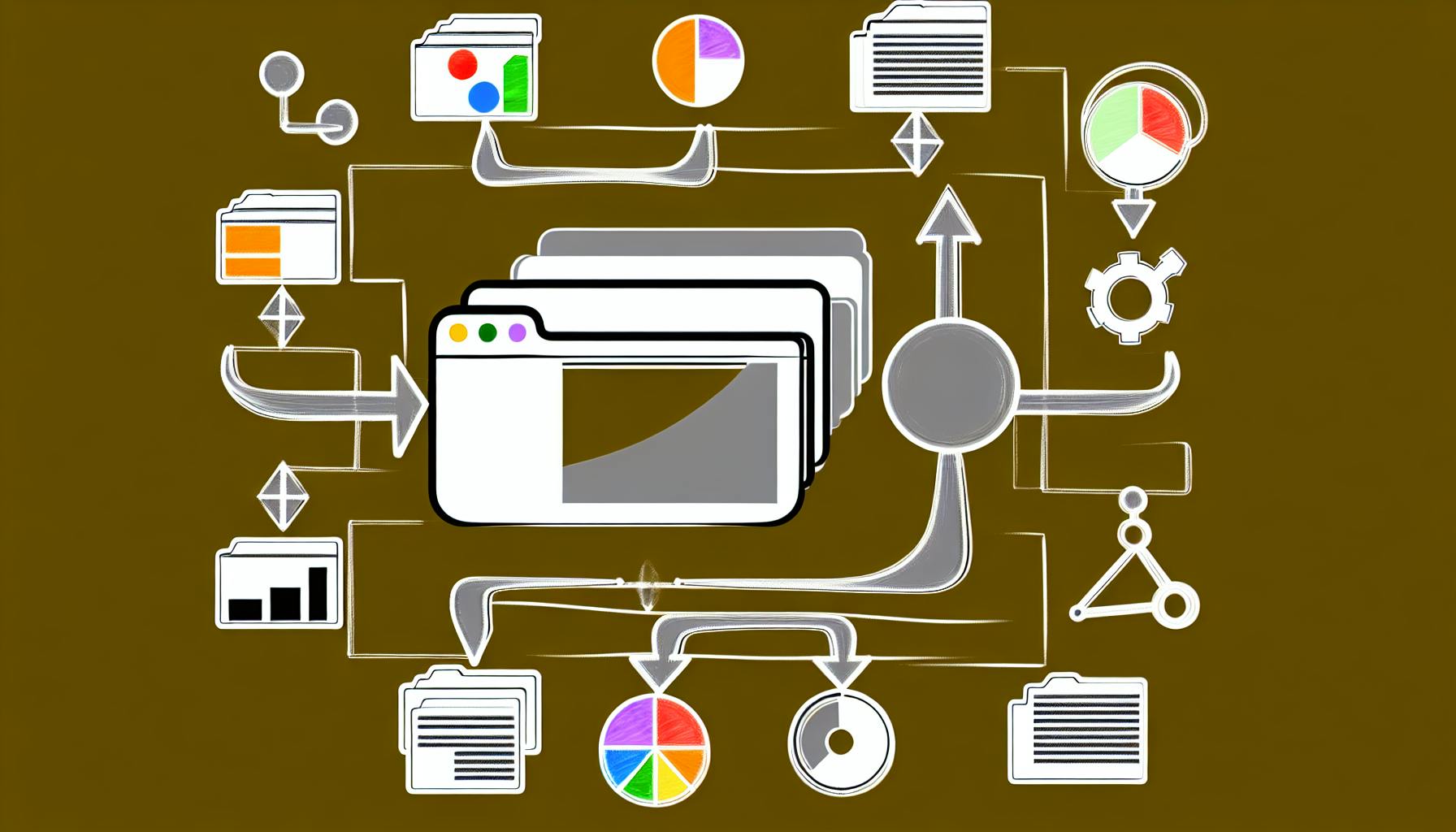Managing data efficiently is crucial for businesses aiming to make informed decisions and improve operations. Here's a quick guide on key strategies for effective data management:
- Organization: Keep data well-structured and easy to access.
- Security: Protect data from unauthorized access and potential threats.
- Accessibility: Ensure the right team members can easily use the data.
- Data Governance: Implement rules for data quality and access.
- Technology: Leverage tools to automate and enhance data management.
- Team Training: Educate your team on best practices.
By focusing on these areas, businesses can harness their data's full potential, leading to smarter decisions and better outcomes.
What is Data Management?
Data management is all about keeping your data in check so it's ready and safe when you need it. It's like having a good system for storing and finding your files, making sure they're correct and safe from prying eyes or getting lost. Essentially, it means keeping your data:
- Available - Making sure the right people can get to the data when they need it.
- Accurate - Ensuring the data reflects real-life accurately.
- Secure - Keeping the data safe from unauthorized access or harm.
- Usable - Having the data in a form that makes it easy to work with and understand.
Doing this well helps everyone work smarter, keeps things running smoothly, and protects against data problems.
Importance of Data Management
Today, data is super important for all kinds of work. Managing it well can give you:
- Informed Decisions - Good data lets you make smart choices and plans.
- Workflow Efficiency - When data is easy to find and use, it saves time and avoids doing the same work over.
- Regulatory Compliance - Sometimes, you have to handle data a certain way by law to protect people's privacy.
- Competitive Edge - Understanding your customers and market better can put you ahead of others.
If you don't manage your data well, it can lead to wasted time, bad decisions, legal trouble, or data breaches.
The Data Lifecycle
Managing data right means looking after it through its whole life:
- Collection - Getting data from different places. It helps to organize it well from the start.
- Storage - Keeping the data in places like databases or the cloud, and making sure only the right people can get to it.
- Usage - Using the data for reports or to learn something new. Having rules about who can do what with the data is important.
- Archival - Moving old data to cheaper storage if you might need it later, but don't want it clogging up your main space.
- Destruction - Safely getting rid of data you don't need anymore according to rules or laws.
For instance, a marketing team might use customer data from different sources to plan a new ad campaign, keep all the campaign info in one place for everyone to use, then look at how well the campaign did to learn from it. After a while, they'll move the old campaign data to storage where it's out of the way but still reachable, and eventually, they'll delete it for good.
Setting the Foundation
First, make sure your plan for managing data helps your business reach its big goals and figure out what data you really need.
Identifying Business Objectives
Talk to people from different parts of your company to understand what they need from data.
- Have meetings with leaders, the operations team, the analytics folks, and others to get a clear picture of what everyone wants to achieve.
- List out the main goals you want to hit with the help of data, like getting more customers to buy something or cutting down on how much it costs to make your product.
- Think about specific ways you can use data to do things better, such as knowing more about who your customers are or seeing how different areas of your business are doing.
- Keep everyone focused on the big picture of using data to make smarter decisions.
Determining Data Requirements
Once you know what you're aiming for, figure out what data you need to get there and set up a system to keep track of it all.
- Check what data you already have and note what's missing that might stop you from reaching your goals.
- Decide what new information you need and how much work it'll take to get and use it.
- Plan a way to easily add new data sources and keep details like who's in charge of it and where it came from.
- Make sure you know what data you need before starting anything new.
- Have a team that includes IT and business people to look at any new requests for data.
Getting clear on what you want to achieve and what data you need from the start makes everything easier later on and helps you see how well you're doing.
Key Components of a Data Strategy
When it comes to managing data, there are a few main parts that help organizations keep their data in check, make sure it's useful, and protect it. Here’s a simple breakdown of what goes into a good data strategy:
1. Data Governance
Think of data governance as the rules and plans that help make sure data is handled correctly. This includes:
- Making sure data is good quality and follows certain standards
- Setting up who can access what data
- Keeping data safe and making sure it's used in a fair way
Having these rules helps everyone trust the data and keeps things safe.
2. Data Quality Management
This part is all about making sure your data is accurate and up-to-date. It involves checking data regularly and fixing any mistakes. Good quality data helps everything run smoothly and makes reports and analysis more reliable.
3. Master Data Management
This is about making sure key information (like details about customers or products) is the same across all systems. It helps avoid mix-ups and makes sure everyone is working with the same information.
4. Data Security
Data security means protecting your data from unauthorized access or loss. This includes using passwords, encrypting data, and having backups just in case. It's crucial for keeping your business safe.
5. Data Privacy
Data privacy deals with handling data in a way that respects people's rights and follows the law. This means collecting only what you need, getting permission, and being clear about how you use data. It's about protecting your users and your business’s reputation.
6. Data Architecture
Data architecture sets up a system for how data is collected, stored, and used. It makes sure data is easy to get to and reliable, whether it's in databases, data warehouses, or data lakes.
7. Leveraging Technology
Using the right technology can help automate tasks, make sense of data through analytics, and provide insights. Choosing tech that fits your strategy can make a big difference in how well you can use your data.
8. Training and Improvement
Keeping up with new ways to manage data and training your team on these methods is key. Regularly checking how you're doing and learning new tricks helps you get better over time.
By focusing on these areas, organizations can make sure their data is well-managed, safe, and useful. This helps with everything from making smart decisions to improving workflow and productivity.
Implementing Your Strategy
Creating Sustainable Processes
To make data management work well over time:
- Understand how data moves in your organization by looking at how it's collected, shared, and used. Write this down to spot any issues.
- Make rules for common tasks like gathering and keeping data. Write these rules down so everyone knows what to do.
- Use tools and tech to do repetitive jobs automatically. This saves time.
- Make it easy for people to get to the data they need by giving them tools and options that fit what they're doing.
- Check how things are going regularly to make sure everything is working as it should. Look for any slow spots or unnecessary steps and fix them.
Establishing Governance
Good rules help with:
- Quality - checking data is right, following standards, and keeping track of data details.
- Security - keeping data safe by controlling who can see it, using encryption, and checking for vulnerabilities.
- Privacy - making sure data is used responsibly, access is limited, and people agree to how their data is used.
- Access - deciding who can see what data and making sure those decisions are followed.
- Ethics - making sure data is collected and used in a fair way.
It's important to keep updating these rules as things change.
Adopting the Right Technology
When picking technology, think about:
- Integration - making sure new and old systems work together.
- Flexibility - being able to add new features when needed.
- Cost - choosing options that are worth the money over time.
- Ease of use - picking tools that are easy to learn.
- Growth - being able to handle more data or users when needed.
- Following rules - making sure the tech meets legal and data handling standards.
It's important to carefully check tech options before choosing.
Building a Knowledgeable Team
To get better at using data:
- Look at what skills you have and where you need to improve, especially in analyzing data and using tools.
- Provide training that fits different job roles on how to use data better.
- Show how data helps different parts of the company.
- Encourage learning by offering rewards or chances to move up.
Promoting a culture that values data starts with support from leaders and involving everyone in decisions.
Executing and Iterating
- Start with small projects to show how things can improve.
- Listen to feedback from those involved to make things better.
- Make small changes based on what you learn before doing more.
- Regularly check your strategy to make sure it still fits with your goals.
Getting better at managing data and working as a team takes time but leads to lasting success.
sbb-itb-9b46b3f
Overcoming Key Challenges
Handling data can be tricky, especially when it comes to making sure the analysis is right, keeping private information safe, and protecting data from threats. Here are some straightforward ways to tackle these challenges.
Data Analysis
Sometimes, the analysis might not be complete or could lead to wrong conclusions if data isn't handled well from the beginning. Here's how to avoid those issues:
Carefully plan analysis
- Decide what you want to find out first.
- Gather all the necessary data for your questions.
- Work with both data experts and business folks.
Clean and organize data
- Fix any mistakes like typos or missing info.
- Arrange data so it's ready for analysis.
- Include details like where the data came from and when.
Validate analysis
- Double-check the methods and data samples used.
- Have someone else review the analysis work.
- Match your findings with what's actually happening.
Iterate approaches
- Start simple and get more complex gradually.
- Make changes based on what you learn.
- Look back at past analyses with new data when available.
By getting the right data, teaming up with experts, and always improving, you can trust the analysis you get.
Data Privacy and Security
Keeping customer data safe means:
Limiting access
- Only let certain people see the data.
- Protect data with passwords and encryption.
- Make data anonymous when you can.
Creating safeguards
- Always have a backup of your data.
- Use software to protect against cyber threats.
- Have a plan ready for if a data breach happens.
Following regulations
- Understand the laws related to your data.
- Always ask for permission to use people's data.
- Make sure your partners are also following the law.
Training all staff
- Teach everyone about how to keep data safe.
- Make sure they know the privacy rules.
- Update training when rules change.
With good access control, safety measures, sticking to the law, and training everyone, you can keep data secure and keep your customers' trust.
Case Studies
Let's look at some real examples where companies used smart data management to make big improvements. These stories show how the right moves can really pay off:
Financial Services Firm Secures Data and Boosts Productivity
A big company that deals with money had a problem: customer information was all over the place, making it hard to keep things safe and use the data well. They decided to put all their data in one spot in the cloud, making it easier for everyone to use and boosting security.
Key Outcomes:
- Made data safer by keeping it in one place and controlling who can see it
- Reporting time went from taking a month to just a few hours because of automation
- Saved $2 million every year by getting rid of old systems
"Thanks to our new way of handling data, our team can spend time on important analysis instead of boring reports. This helps us make decisions based on data." - CTO
University Uses Data to Enhance Student Experience
A university wanted to get more students to join and make sure they had a good experience. They did this by looking at data to understand each student better, which helped them reach out in a personal way and make starting at the university smoother.
Key Outcomes:
- 10% more students joined because of better recruitment efforts
- Fewer students left the university, with a 7% drop in dropout rates over two years
- Personalized messages made students happier
"Now, we see students as individuals, not just numbers. We can offer help that's tailored to what they need." - Enrollment Director
Data Platform Powers Ecommerce Recommendations
An online shopping company was having trouble suggesting products that customers would like, which meant lost sales. By using a system that keeps track of what customers do and like, they could suggest products more accurately.
Key Outcomes:
- People bought 15% more stuff when suggestions were on point
- The company saved money by using one system instead of many
- Trusted data helped the company grow and try new things
"Our better way of using data has been super helpful, especially as we add more things to sell. We know we can give our customers what they want." - CMO
These stories show that with a smart plan for handling data, companies can save money, work more efficiently, and make smarter choices - while keeping data safe and easy to get to. The right strategy can change the game for any business.
Conclusion
Managing data well is really important for businesses that want to make smart choices and get more done. By focusing on keeping data organized, safe, easy to get to, and using the right tech, companies can handle their data better from start to finish.
Here's what to remember:
- Make sure your data plan helps you reach your big goals. Figure out what you need to know and gather the right info.
- Set up clear rules for how to handle data. This includes making sure it's good quality, keeping it private, protecting it, and deciding who can see what. This makes people trust your data more.
- Help everyone find and use the data they need easily. This means setting up your systems in a way that works well and lets people access data without hassle. This saves time and encourages a culture where everyone uses data to make decisions.
- Pick tech tools that help automate boring tasks, fit well with what you already have, and can grow with you. The right technology makes everything smoother.
- Teach your team about data and keep learning together. Knowing how to use data well is a big advantage.
- Always check how you're doing and be ready to make changes. Keep an eye on new ways to do things and new rules you need to follow.
By taking a step-by-step approach and focusing on people, how things are done, and technology, businesses can turn data from a headache into a big help. Looking at what you're doing now and finding ways to do it better is key to doing well in the long run.


